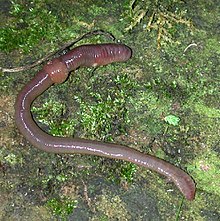
Back Wurm Afrikaans Cuco AN دودة Arabic ܬܘܠܥܐ ARC Viérbene AST Laq'u Aymara سولوجانلار AZB Селәүсен Bashkir Kėrmėns BAT-SMG Ulod BCL

A worm is a bilateral animal. It usually has no arms or legs, and a slender cylinder-like body.
Worms come in many different sizes. Some species are very small, while the bootlace worm has been known to grow up to nearly 60 meters (almost 200 feet).[1] One of the best-known types of worms are earthworms.
Worm is not a term used by itself in animal classification. There are worms which belong to several phyla. Examples of words include: Annelids, nematodes, platyhelminthes, ribbon worms, arrow worms, priapulid worms, and some insect larvae. They are all animals which may be called 'worms'.
- The Platyhelminthes includes the flatworms, tapeworms, and flukes. They have a flat, ribbon or leaf-shaped body with a pair of eyes at the front. Some are parasites.
- The second group has the threadworms, roundworms, and hookworms. This phylum is called the Nematoda.
- The third group is the segmented worms: the Annelids. Their bodies are divided into segments or rings. Among these worms are the earthworms and the bristle worms of the sea.
Many unrelated insect larvae are called "worms", such as the railroad worm, woodworm, glowworm, bloodworm, inchworm, mealworm, silkworm, and woolly bear worm.
Worms may also be called helminths, particularly in medical terminology when referring to parasitic worms, especially the Nematoda (roundworms) and Cestoda (tapeworms). "Helminthology" is the study of parasitic worms. When a human or an animal, such as a dog or horse, is said to "have worms", it means that it is infested with parasitic worms, typically roundworms or tapeworms. Deworming kills off the worms that have infected a human or animal by giving anthelmintic drugs.
"Ringworm" is not a worm at all, but a skin fungus.
- ↑ Mark Carwardine 1995. The Guinness Book of Animal Records. Guinness Publishing, p232.